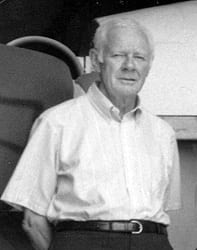Arnold G. Sharp
The Woods Hole Oceanographic Institution announces with great sorrow
the death September 3, 2005 of Arnold G. Sharp at Cape Cod Hospital in
Hyannis after a brief illness. He was 82.
Arnold Gideon Sharp was born May 16, 1923 in Worcester, MA and attended
schools there, graduating from South High School in 1941. He enlisted in the U.S. Naval Reserve in 1943, attended the U.S. Naval
Reserve Midshipmen’s School at Columbia University in 1945, and served
as an ensign in the U.S. Naval Reserve in the Pacific during
1945-1946. He received a B.S. degree in mechanical engineering
from Tufts University in 1946, and was an instructor at Worcester
Polytechnic Institute from 1947 to 1953, when he received a M.S. degree
in mechanical engineering from the school. Arnold Sharp worked as an
assistant professor at the University of Massachusetts from 1953 to
1958, and was a lecturer at Lincoln College, Northeastern University,
from 1960 to 1961. He did postgraduate work in engineering mechanics at
Northeastern University from 1962 to 1966.
His affiliation with the Woods Hole Oceanographic Institution began
with a summer job in 1956. He returned the following summer, and was
hired as a mechanical engineer on a full-time basis in November 1958,
working with Allyn Vine. He was promoted to research associate in
1963, to research specialist in 1978, and to senior engineer in 1991.
He retired from WHOI in July 1988 and remained active until
recently. At the time of his death he was working at the Institution on
a
casual
basis.
His research interests included underwater acoustics and underwater
sound generators, fastening and joining methods, winch and winch drum
design, deep submergence vehicle design, and oceanographic pressure
vessel design. Arnold Sharp was the author or co-author of more than 25
publications, and he held a patent for an impact energized sound source.
Through the years he served in an advisory capacity and provided
engineering assistance to a number of graduate students both in the
MIT/ WHOI Joint Program and from other institutions.
Throughout his career beginning in 1947 he worked as a private engineering consultant in
stress analysis and structural design. He was a member of the
Society of Naval Architects and Marine Engineers, and the Society for
Experimental Stress Analysis.
A quiet and cheerful man, Arnold Sharp was known as a skilled
structural engineer whose work was meticulous and accepted with
confidence. He played a major role in the Deep Submergence
Vehicle Alvin program from
the beginning, serving as as structural design and stress analysis
engineer for the sub’s titanium frame and personnel sphere and for
support vessel Lulu. He also
designed and tested the emergency forebody release device for the submersible,
studied and tested the electrical penetrators, and redesigned and
tested a new drum for the trawl winch on R/V Knorr. Among his other major accomplishments were the design, weight and
stability calculations for sediment transport tripods for USGS, an in
situ seawater sampler, and for a bottom mounted current meter.
Co-workers in the Alvin Group rememeber Arnold fondly, noting that he
was a pleasure to work with and always had the right answer. “His
expertise was particularly valuable when Alvin
was modified to increase its depth capability from 6,000 feet to nearly
15,000 feet, and again when the submersible moved aboard Atlantis II from the original support ship Lulu,”
a colleague said. ” In each case, Arnold’s efforts were largely
responsible for the positive outcome. The National Deep Submergence
Facility will greatly miss him as a friend and engineer.”
Survivors include his longtime friend, Bernice E. Salmonsen of
Brewster, MA. There were no funeral services, and burial in All Faith’s
Cemetery in Worcester, MA was private.

